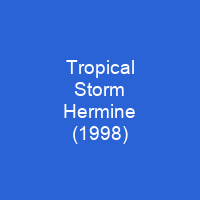Tropical Storm Hermine was the eighth tropical cyclone and named storm of the 1998 Atlantic hurricane season. Hermine developed from a tropical wave that emerged from the west coast of Africa on September 5. Residents of Grand Isle, Louisiana, were evacuated. Rainfall spread from Louisiana through Georgia, causing isolated flash flooding. As a weak tropical storm, damages from Hermine were light.
About Tropical Storm Hermine (1998) in brief

It progressively weakened as the circulation moved northeastward, and dissipated at 1800 UTC on September 21. The tropical storm-force winds were confined to the eastern semicircle of the cyclone, and then deteriorated into a tropical depression. On its landfall, associated rain bands were deemed \”not very impressive\”, although there was a rapid increase in thunderstorm activity east of the center. The thunderstorms produced heavy rainfall in parts of southeastern Louisiana and southern Mississippi. On September 17, the National Hurricane Center issued a tropicalStorm watch from Sargent, Texas to Grand Isle,. Louisiana. The following day, the watch was extended southward to Matagorda, Texas, and eastward to Pascagoula, Mississippi. As the storm moved inland, flood warnings and advisories were issued for southern Louisiana and Intracoastal City, Florida. Workers were evacuated from the oil rigs in the Gulf, and energy futures rose substantially in anticipation of the storm. Only fifteen people entered the Red Cross shelter in Larose, Louisiana.
You want to know more about Tropical Storm Hermine (1998)?
This page is based on the article Tropical Storm Hermine (1998) published in Wikipedia (as of Nov. 11, 2020) and was automatically summarized using artificial intelligence.







